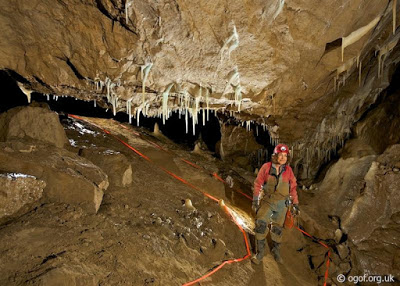Caves may contain calcite formations (speleothems), fauna, fungi and even bacterial life. Whilst any of these may be threatened from time to time, the greatest threat is to caves themselves.
The most common risks to the caves of North Wales include.....
-
Quarrying (total or partial loss of entire caves)
-
Pollution (most commonly from diesel, chemical or sewage discharges)
-
Neglect by local archaeological organisations (failure to take action when caves are threatened)
-
Explorer damage (to formations, or lack of awareness)
Where conservation is required, two questions need to be addressed: What methods should be applied and who should apply them?
Ideally, individual cavers are aware of their environment and where archaeology, delicate formations or life-forms are encountered, measures are taken to ensure their protection….…
“Cave conservation should be the responsibility of every active caver. It should not be regarded as the special preserve of a few aged armchair cave politicians” according to David Judson, in ‘Caving Practice & Equipment’ 1984.
Conservation measures undertaken by individual cavers commonly include:
· The taping-off of delicate formations (guiding cavers along safe routes)
· Ensuring cave environments are, where possible kept in their original condition
· Recording by photography of delicate formations or life-forms
· The reporting of archaeological remains as soon as they are found
The following motto has been adopted by cavers for many years….
- Take nothing but pictures
- Leave nothing but footprints
- Kill nothing but time

Where entire caves need protecting in some way, there's a need for a more organised approach. In most areas of the UK, cave access committees represent interested parties. These allow methods of conservation to be openly discussed and agreed, before being implemented…….
“………… access restrictions in the interests of conservation should be a tripartite agreement between the landowner, the discoverer (perhaps an individual, more likely a caving club) and representatives of cavers at large – a regional caving council.
Time and time again, when an individual caver, caver/owner or even an individual caving club has tried to establish its own access control over a cave, the attempt has not been well received and has led to misunderstanding and animosity.
At the extreme, a cave with its entrance effectively sealed off by the landowner is a cave which is being totally preserved! There should be a happy balance and an agreed solution which must, in the case of the more vulnerable caves, lie somewhere between complete closure and a complete free-for-all.” (Judson 1984).
Currently there are two caving areas in north Wales designated as SSSIs and protected by statute:
1) Alyn Gorge Caves SSSI
2) Ruabon/Llantisilio Mountains & Minera SSSI
Great
strides have been taken in other areas where amateur and professional
bodies are co-operating in the monitoring of caves. One such is the
monitoring of northern caves by cavers working together with Natural
England. Standard forms have been devised that are freely available for
cavers to download from the Internet, and as a result of this
co-operation, problems can be identified and remedial action taken to
minimise damage to cave sites. There is no good reason why such an
approach could not be adopted in North Wales. For further information,
see the link below, named 'Natural England Cave Monitoring Scheme'.